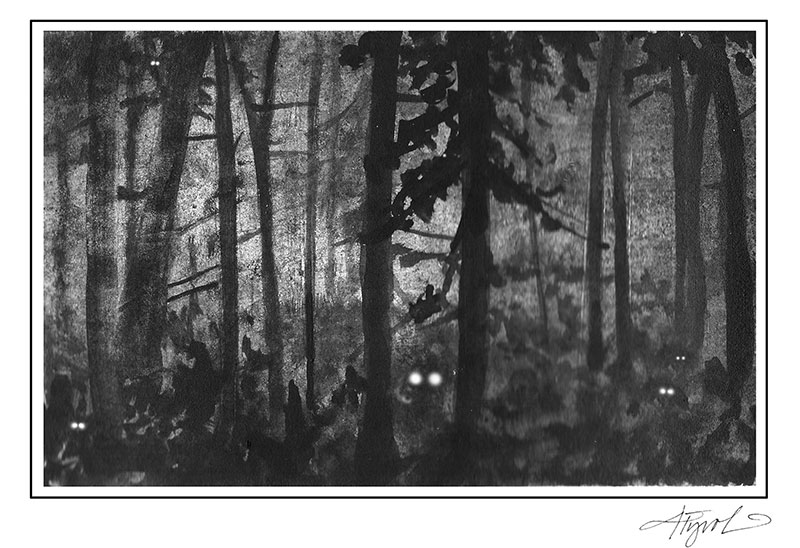What Animal Eyes Reflect Red St Night
I've taken to wandering the night lately — one of the pleasures of having a puppy. Willow, my pup, and I walk at all hours, from twilight to midnight and into the shadowy early morning. Some nights we walk under the cover of stars and moonlight, and other nights the world is and so dark my black domestic dog disappears and I wonder what exactly is on the end of my leash.
Void of visual stimulus, whatsoever earthbound glimmer of lite is noteworthy. One night I saw the glow of 2 minor eyes, like gold coins defenseless in the arc of my headlamp. I watched the weasel — a long small torso, and bold shimmering optics — disappear downward the cleft of a stonewall. Since then I've become obsessed with eyeshine.
Eyeshine in animals is produced by a special membrane, chosen the tapetum lucidum ("tapestry of calorie-free"), a cogitating surface that is located straight behind the retina. When the small rays of low-cal found in the night, like starlight or moonlight, enter the eye, they bounce off the membrane, giving the eye a 2d risk to use the light. For animals that have this membrane, information technology is like having a built in flashlight that lights a path from the inside out.
The tapetum lucidum, coupled with large eyes and lots of light-sensing rod cells, allow nocturnal mammals to see well in dark or dim atmospheric condition. But eyeshine isn't express to mammals. Once, while at the edge of a pond listening to the midnight chorus of frogs, my flashlight caught the glimmering, emerald-green eyes of a huge bullfrog. And in my obsession over eyeshine, I am eagerly looking forward to the summer, when I will be searching the forest flooring for the ruby red glow of a wolf spider's eyes. I only wish that my eyes would glow, a fierce sapphire bluish in the darkest of night, just although humans take many interesting adaptations, good night vision is not one of them. Our affluence of cones and lack of rods mean we run into more colors than almost other animals, but we can't see in the dark. And we don't accept a tapetum lucidum — when our eyes announced cerise in photographs, information technology'south a reflection of the photographic camera'due south flash off the cherry blood cells of the choroid, which is a vascular layer behind the retina.

Eyeshine in animals. (Illustration by Adelaide Tyrol.)
Eyeshine color varies by species, from the amber glow of a bobcat to the crimson glint of a black bear. The unlike colors are produced by the mineral content and the structure of the tapetum lucidum, too as varying pigments in the retina. In that location does seem to be some overlap of colors, like bobcat and raccoon having yellow/bister eyeshine.
So is it at all possible to place an fauna by eyeshine color lonely? According to ecologist and long-time tracker Dr. Rick van de Poll, eyeshine is somewhat variable and then that even within the aforementioned species the color can look a bit dissimilar. Factors that influence individual eyeshine color, co-ordinate to van de Poll, include the historic period and individual chemistry of the beast, as well as seasonal variation and the angle and intensity of the lite hit the heart. Only this doesn't deter van de Poll from using eyeshine equally a clue to identifying mammals. "Information technology'due south part of the information" he said, "just you take to as well be paying attending to the animal's behavior, the shape and placement of the eyes, and how the animate being moves away from the light, or if it fifty-fifty moves abroad from the light at all."
As we caput out into the dark, my headlamp strapped on above my optics, I catch Willow's red glowing eyes looking upwardly at me. Out in front of us is a field, and nosotros sentinel a set of green/white eyes lift up and turn towards us. These eyes are high and broad. There is a stamp and a snort and the eyes are gone – starlight on the move. My light catches the flash of a white tail as the deer disappears into the nighttime.
Susie Spikol is Community Program Managing director for the Harris Center for Conservation Pedagogy in Hancock, New Hampshire. The illustration was drawn by Adelaide Tyrol. "The Outside Story" is assigned and edited by Northern Woodlands magazine, and sponsored past the Wellborn Ecology Fund of the New Hampshire Charitable Foundation, a fund dedicated to increasing environmental and ecological science knowledge. Electronic mail wellborn@nhcf.org. for more than data. A book compilation of Exterior Story articles is bachelor at http://world wide web.northernwoodlands.org.
Source: https://www.nhcf.org/what-were-up-to/why-animals-eyes-shine-at-night-but-peoples-dont/
Posted by: oliveirahileboseek.blogspot.com

0 Response to "What Animal Eyes Reflect Red St Night"
Post a Comment